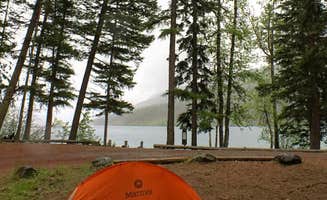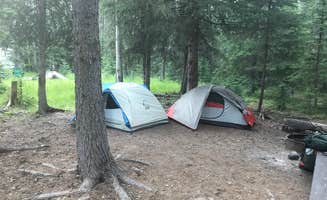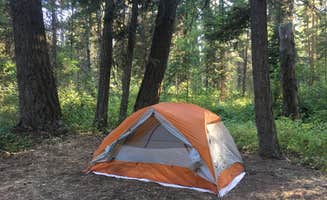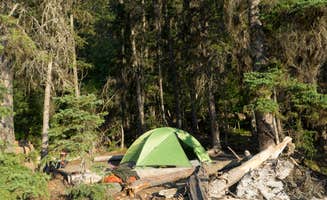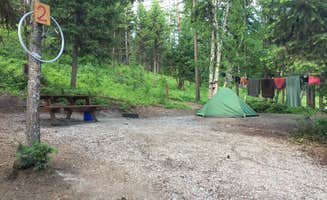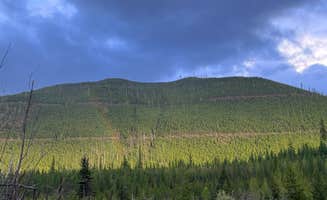Tent camping near Eureka, Montana provides access to the Kootenai National Forest's diverse terrain, with elevations ranging from 2,000 to 7,700 feet. Summer temperatures typically reach 70-85°F during daytime, dropping to 40-50°F overnight, while spring camping often requires preparation for muddy forest service roads and potential afternoon thunderstorms. Primitive campsites throughout the region offer varying levels of seclusion depending on their proximity to major recreation areas.
What to do
Kayaking and fishing: Kintla Lake in Glacier National Park offers exceptional non-motorized boating experiences about 40 miles from Eureka. "We kayaked and tent camped for 2 nights. Highly recommend making the effort," shares a visitor at Kintla Lake Campground. The lake is known for productive fishing, with one camper reporting, "We fished here and within 30 seconds of dropping my line I caught my first lake trout!"
Hiking trail access: Multiple trails begin directly from campgrounds in the area. At Bowman Lake Campground, campers can access lakeside and mountain trails without driving. "There are several trails leading you to amazing views of the lake and surrounding mountains," notes a reviewer, while another mentions "a trail took us along the lake shore which was one of my favorite walks."
Wildlife viewing: The region hosts abundant wildlife including deer, birds, and bears. Practice proper wildlife safety, especially food storage. A visitor to Bowman Lake noted, "We saw multiple deer, various birds, a grizzly on way in," while another mentioned, "deer frequent the campsites, sniffing around the fire pits, searching for food, and they're not scared of people."
What campers like
Quiet, non-motorized lakes: The remote lakes near Eureka provide peaceful experiences away from crowds and motorboats. At Kintla Lake Campground, a visitor appreciated that "this part of the lake also does not allow motorized boats so kayaking and canoeing is very pleasant." Another noted it feels like "you are in on a secret, and you get to share it with roughly 30 strangers."
Early morning views: Dawn provides spectacular views at many campsites. A camper at Bowman Lake Campground shared, "I couldn't sleep any more so I got up at 4:30, made coffee, and walked down to the lake about 5 am. It was like a painting." The mountains reflecting on still morning waters create memorable vistas throughout the region.
Hammock-friendly forests: The forested campsites provide ideal hammock setups. At Bowman Lake, one camper noted, "All my friends and I have hammocks, so we always like staying in a campsite that has good trees to hang our hammocks. We were able to get a spot where there were trees really close to our campsite." Another review confirmed "lots of shade and hammock trees" at the campground.
What you should know
Access road conditions: Many campsites require driving on rough, unpaved roads. For Bowman Lake Campground, a visitor warns: "Be prepared for a dusty, bumpy, narrow, pot-holed drive in on the road. If the road is wet, it is treacherous!" Another notes, "It takes several miles of semi-rough gravel road to get there," while a third adds, "The road is pretty narrow, so just be careful of oncoming cars."
Limited spaces and no reservations: Most primitive campgrounds fill early, especially during peak season. "You need to arrive early to find a site as there are a limited number of sites," advises a Kintla Lake camper. Another points out, "They don't take reservations, and the campground isn't very big...limited spots."
Bear safety requirements: The entire region is grizzly country, requiring strict food storage. In primitive areas like Martin Lake, campers advise storing "food by hanging from high tree branch to discourage bear investigations." At Bowman Lake, visitors noted "a leather deposit of bear scat on the Bowman Lake trail" and were "surprised there was only one bear box for the whole campground to share."
Tips for camping with families
Insect preparation: Mosquitoes can be intense during summer months. Pack sufficient repellent and protective clothing. A visitor to Bowman Lake warns, "The mosquitos will about drive you nuts," while another states, "I experienced more mosquito bites here than at any other spot in Montana. Bring your repellant!"
Weather preparedness: Pack for significant temperature fluctuations, especially at higher elevations. "You'll be at high elevation so be ready for cooler nights. I used my 0-degree sleeping bag, and that worked great," shares a Kintla Lake camper. Afternoon thunderstorms are common during summer months.
No cellular service: Plan for complete disconnection from phone and internet. "No cell service for many miles out," reports a Bowman Lake visitor. Download offline maps, bring physical maps, and inform others of your itinerary before heading to remote camping areas.
Tips from RVers
Vehicle restrictions: Many remote campgrounds have limitations on vehicle size and type. At Kintla Lake, a visitor notes, "No trailers or campers allowed," due to the narrow, rough access roads. Another explains this is "not for trailers or RV's due to the road in, but tent campers and truck campers are fine."
EV charging limitations: Electric vehicle users should plan charging carefully. A Bowman Lake Campground visitor notes, "For EV owners, the closest L3 chargers I saw were in Kalispell maybe 50 miles south. I had no trouble with the round trip or the terrain in my Kona."
Drive time planning: Allow extra time for reaching remote campgrounds. The drive to Kintla Lake "will take near an hour and a half" despite being only 39 miles inside the park, according to one visitor. Road conditions significantly extend travel times compared to paved highways.


